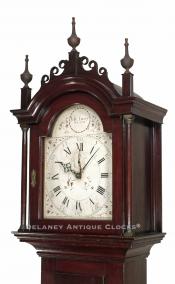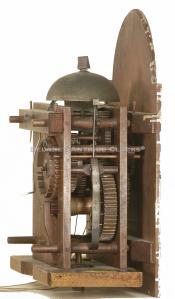Jesse Emory of Weare, New Hampshire. Wooden geared tall case clock. JJ-239.
This clock is a masterpiece crafted by the renowned Jesse Emory of Weare, New Hampshire. Emory, a highly respected figure in the antique clockmaking community, was known for his exceptional craftsmanship and innovative designs.
This clock, a masterpiece in its class, showcases exceptional craftsmanship. The case, with its well-proportioned design and original grain-painted surface, is a testament to the skill of the rural cabinetmakers who chose birch, an indigenous wood, for its construction.
The base stands on four boldly formed cutout feet. They retain excellent height. The waist is long and narrow and features a rectangular-shaped waist door. I'd like you to please note the unusual construction of the wooden door lock. It is skillfully crafted. It is interesting to note that Jesse Emory is known to have made his own clock cases and door locks. The bonnet is a traditional New England form. It features a wonderfully patterned fretwork design positioned between three tall chimney plinths. The plinths support turned wooden finials. The bonnet door is in an arched form and fitted with glass. It opens to allow one access to the hands. Fully turned bonnet columns flank this door. They end in wooden capitals that retain their original gilding.
The thick wooden dial is maple. It is skillfully decorated in red and blue, the chapter ring is black, and the Maker signs it along with the working location in the arch.
The time and strike weight-driven movement, a hallmark of this Maker's clocks, is a testament to the quality of this piece. Constructed in wood with oversized gearing, it is designed to run for 30 hours on a full wind and features a count wheel strike, making it a technical marvel for any clock enthusiast.
This clock stands 7 feet 5.5 inches tall.
This fine example, crafted by Emory circa 1795, has a rich history that connects us to the past and is a testament to the enduring craftsmanship of the era.
Inventory number JJ-239.
Jesse Emory of Weare, New Hampshire. A mechanic, farmer, and an ingenious wooden geared clockmaker. He is renowned for creating some of the finest Wooden geared clocks in America, a significant achievement in a time when clockmaking was a highly respected craft.
Jesse Emory was born on July 17, 1759, on Craney Hill in Weare, New Hampshire. He was the son of Caleb Emory, originally from Amesbury and Haverhill, MA, and Susannah (Worthley (1740-1835)). His parents moved to Goffstown and then to Weare around 1758. Jesse is reported to be the first male born in the town and one of the first New Hampshire-born Clockmakers. At the age of twenty, on September 20, 1779, Jesse enlisted in Captain Lovejoy's Company for the defense of Portsmouth. He was discharged two months later. Jesse, a farmer and a mechanic, was living in the northwest corner of Henniker near Weare when he married Hannah Corliss on November 20, 1783. She bore him one daughter, Ruth. Hannah's brother was James Corliss, who owned a gristmill downstream and would become a competitor of Jesse's in the clock business. On February 18, 1794, Jesse purchased 27 acres of land and a building on Mt. Dearborn Road in Weare near the Henniker town line from his father-in-law, Jeremiah Corliss. He set up shop here in a business-friendly section called Meadowbrook. Jesse manufactured clocks from this location until early 1806. Emory was a complete clockmaker, producing his own movements, dials, and often cases. All of which were made to the
highest standards. Jesse stayed there until 1806, when he sold some land in Weare and moved to Deering, NH. The Town Histories of Henniker and Weare and the deeds recorded for this land transaction listed Emory as a mechanic, farmer, and yeoman. He is reported to have made spinning and flax wheels, measures, harnesses, and clocks. It is speculated that he moved because of the competition from James Corliss and Abner Jones, who were making clocks nearby. On July 19, 1806, Jesse bought approximately 50 acres in Deering from Jonathon French. Jesse's second marriage was to Betsy Wyman of Hillsborough, New Hampshire, in 1814. On October 3, 1826, Jesse purchased 34 acres of land in Henniker from Jonathan Green. This land became the Emory farm on Peasley Road. Jesse died on July 10, 1838, at the age of 79. His gravesite is not currently known.
Emory was a skilled cabinet and clockmaker. His design and execution are that of legend. He made the entire clockworks and cases for each out of wood. Eleven of the twelve clocks recorded are fitted with thirty-hour pull-up movements. (One eight-day key wind example has been identified.) The works are constructed entirely of maple. The large, heavy plates are highly finished and are supported with five turned and shaped posts. This framing is secured to the seat-board with a wooden screw that threads into the middle pillar or post of the movement. The robust gearing is oversized. The largest of the wheels, the great wheels, are approximately an inch thick. The wide wheels allowed for large teeth that increased the surface area for each tooth. This made them stronger and added to the longevity of the works. These wheels are undercut and incorporate three gravity clicks on each of the winding arbors rather than the typical spring, click, and ratchet mechanism. The clicks fall into place as designed. Each wheel in the gear train is finely finished. Many are designed with an undercut detail. The escapement is a recoil, a mechanism that controls the motion of the gear train. The hour hand and date hands are driven from the minute hand through gearing. The strike train features a count-wheel positioned at the back of the movement.
The dials of Emory clocks are handmade and skillfully painted on a maple blank. The dials are often signed "Jesse Emory / WEARE" in the arch. Other examples are signed "Jesse Emory / of / WEARE." The white background is polished and smooth. Many of the painted details are laid into the dial. In other words, Emory took the time to engrave the dials before he applied the colors. The incising of the dial was probably done to prevent paint bleeding. The four-color decoration includes black, red, pink, and blue/green. Emory also constructed his cases, which are typically made of birch or maple wood. A fair number of these retain their original grain-painted surfaces. A number of his cases incorporate a unique door latch. Very few clocks are known by this ingenious Maker. Approximately 12 clocks are recorded.
















